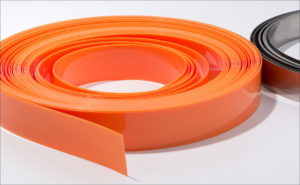 Steel doctor blades used to be a printer’s only option to produce high-end graphics. It wasn’t because he didn’t want longer blade life and the safety benefits that came with using plastic, steel was simply the only material that could sufficiently meter a high line screen roll. Not anymore! Today’s next generation polymers and advanced tip engineering have at last resulted in a non-metallic doctor blade with the metering quality of steel. This blade can replace steel doctor blades in a full range of flexo printing applications from solids and lines, to reverses and fine print, to screens and process work. Here’s why.
Steel doctor blades used to be a printer’s only option to produce high-end graphics. It wasn’t because he didn’t want longer blade life and the safety benefits that came with using plastic, steel was simply the only material that could sufficiently meter a high line screen roll. Not anymore! Today’s next generation polymers and advanced tip engineering have at last resulted in a non-metallic doctor blade with the metering quality of steel. This blade can replace steel doctor blades in a full range of flexo printing applications from solids and lines, to reverses and fine print, to screens and process work. Here’s why.
Steel Doctor Blades vs. Traditional Plastic
Due to its thinness and stiffness, steel has been the only blade material that could achieve a fine point of contact sufficient to execute a clean wipe on a high line screen anilox roll. By comparison, the characteristics of traditional plastic doctor blades require them to be thicker to provide the same rigidity. While they have other benefits in terms of safety and blade life, their thickness prevents them from maintaining a fine contact area with the anilox. As they wear and their contact area with the anilox roll grows, plastic blades produce changes in tonal value and dot gain when metering high line screens. For this reason, they have historically been limited to jobs with low to modest graphics requirements.
Next Generation Polymers
Now, specially formulated polymer doctor blades can compete with steel in the most demanding graphics applications. Unlike traditional plastic, the stiffness of the next generation material with a precisely engineered MicroTip™ edge allows the TruPoint Orange doctor blade to achieve and maintain a fine contact area with the anilox roll. Orange can deliver effective metering on line screens up to 2,000 lpi (785 L/cm) and produce graphics of the highest quality. The following diagrams compare the contact areas of traditional plastic, steel and next generation polymer blades:
As shown, the contact area of a worn traditional plastic blade grows to .060″ (1.52mm) compared to a contact area of .016″ (.40mm), for a worn steel blade. The next generation polymer is able to maintain a contact area of .012″ (.305mm), equal to or smaller than that of most steel doctor blades, throughout the life of the blade due to the edge design. The engineered tip wears slowly and evenly and delivers consistent ink film thickness for the duration of the print job.
Today’s innovations in polymer doctor blades offer printers a viable alternative to steel. A combination of advanced materials and new tip technology has yielded a blade that meters as well as steel on the highest line screens yet retains the benefits of traditional plastic. Printers no longer have to compromise on anilox scoring, blade life, and safety to fulfill the most demanding graphics requirements!

